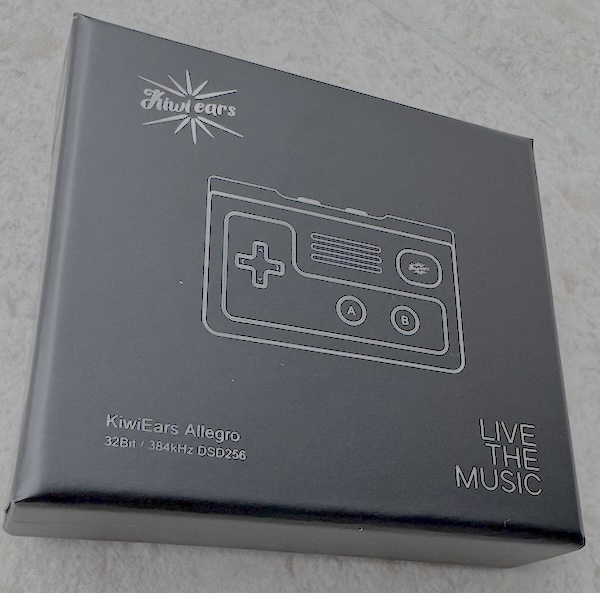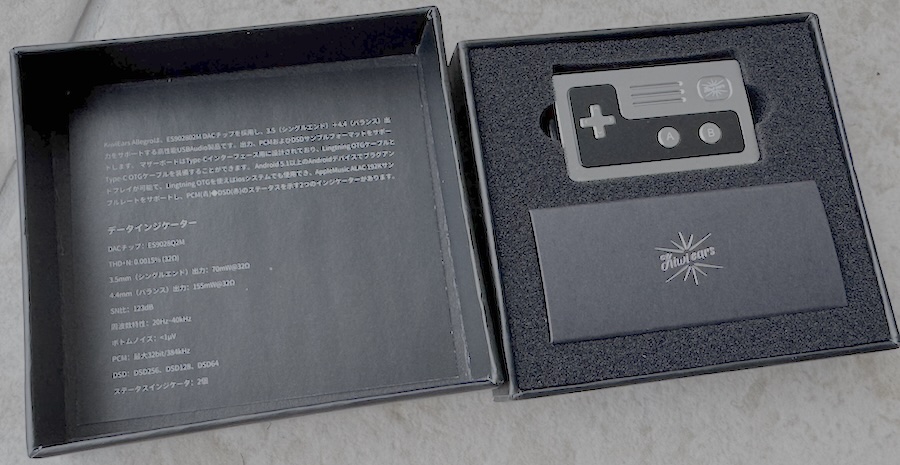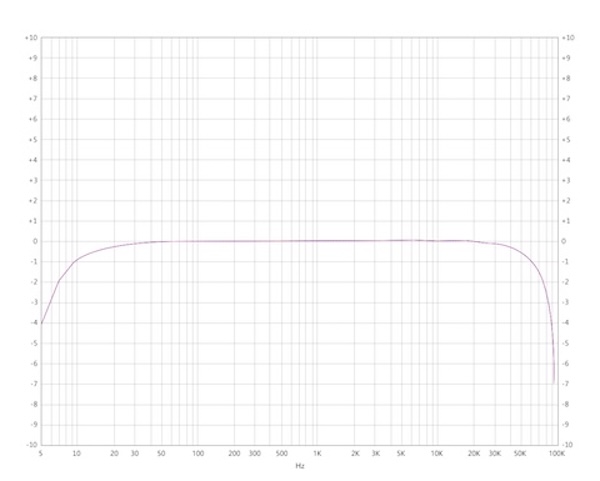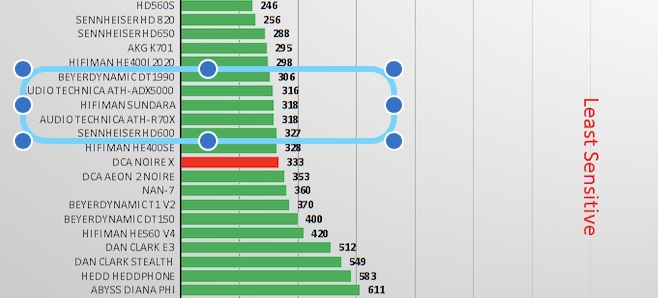Kiwi Ears Allegro
A retro styled portable powerful headphone DAC/amp
The Kiwi Ears Allegro is a mid-priced retro-styled headphone DAC amplifier aimed at delivering high-quality sound from a fun looking compact device. The Allegro does it job exceptionally well, though for me personally the gaming themed buttons on the front of the device distract a little for an otherwise exceptional device:

The Allegro’s audio quality from both its 3.5mm and 4.4mm outputs make it a great choice for those looking for a reliable DAC amp in this price range (as you will see in the measurements section later).
Note: Thanks to Kiwi Ears for providing the Allegro for this review.
If you are interested in more information check out Kiwi Ears product page here
Where the Allegro is currently on sale for $50.99
Unboxing Experience and Box Contents
The Kiwi Ears Allegro comes in simple box:

Some key specs on the back:

Opening the box you see the Allegro and a nice cable in the box:

Design and Build
While the Allegro’s build quality is good, featuring a sturdy aluminum chassis, I personally think the retro gaming design slightly spoils what internally is a very decent headphone DAC amplifier. Mostly I feel it is a pity the volume control wasn’t the A / B buttons on the front of the Allegro or alternatively the ‘arrows keys’ on the fake game control would actually work maybe toggle some gain settle or filters.
Internals
But the key thing with the Allegro are the internals
Dual DAC Architecture
The Allegro is powered by ES9028Q2M DAC chip, which offer excellent detail retrieval, low distortion, and a smooth flat frequency response. This architecture provides separation and clarity, ensuring each channel is processed with precision for an immersive listening experience.
4.4mm Balanced Output
The inclusion of a 4.4mm balanced output is a valuable addition for those using balanced headphones, providing enhanced power output and improved channel separation. This output is particularly useful for higher-impedance headphones, which benefit from the added power and control of a balanced connection.
Sound impressions
The Kiwi Ears Allegro shines in its audio performance, providing a balanced and refined sound signature that works well across various genres. Its power output is sufficient for a wide range of headphones, from sensitive IEMs to more demanding over-ear models, ensuring a consistent and satisfying listening experience.
Bass
The bass on the Allegro is tight and well-controlled, offering a solid foundation without overpowering the other frequencies. Tracks like “In the Air Tonight” by Phil Collins demonstrate the Allegro’s ability to reproduce deep bass with precision and texture, making it a great choice for genres that require accurate low-end reproduction.
Midrange
The midrange is clear and articulate, providing excellent reproduction of vocals and instruments. The Allegro’s tuning lends itself well to vocal-centric tracks, with a smooth, natural quality that enhances both male and female voices. In “Rolling in the Deep” by Adele, the Allegro captures the nuances of her voice with warmth and clarity.
Treble
The treble response is detailed and well-extended without being harsh, allowing for an airy quality that enhances overall transparency. It handles high frequencies gracefully, making it suitable for genres that rely on treble detail, like classical and jazz. The Allegro ensures cymbals and string instruments sound crisp without any harshness.
Soundstage and Imaging
The Allegro offers an impressive soundstage for a DAC amp in this price range, with good width and depth that create a natural listening environment. Imaging is accurate, allowing listeners to pinpoint instrument placement within the sound field, which adds to the sense of immersion. The balanced output, in particular, contributes to a more expansive soundstage, enhancing spatial accuracy.
Specifications and Measurements
| Specification | Details |
|---|---|
| DAC CHIP | ES9028Q2M |
| THD+N | 0.0015% (32 Ohms) |
| OUTPUT POWER | 70mW@32 Ohms (3.5mm), 155mW@32 Ohms (4.4mm) |
| SNR | 123dB |
| FREQUENCY RESPONSE | 20Hz~40kHz |
| NOISE FLOOR | <1μV |
| SUPPORTED FORMATS | PCM (up to 32bit/384kHz), DSD (DSD256, DSD128, DSD64) |
| INDICATOR LIGHTS | PCM (blue), DSD (red) |
Practial Measurements and Comparisons
Why I am calling this a ‘practical measurement’ section?
DAC should be transparent windows into your audio collection
You will often see reviews on head-fi (and other websites) talking about the subjective differences between different headphone DAC amps, one having a better bass response or another focusing on the midrange while a third might give you a more detailed treble and this was certainly the case in this market as recent as 3 years ago. And especially was the case at both the cheaper end of the market (as the technology was not as matured) but it can also for the very high end where manufacturers want to distinguish their devices with unique sound signature.
But in my opinion, DAC and Amplifiers should not change (by design) the sound signature, though obviously some implementations are better than others and some implementations (like Tube amps) will deliberately ‘colour’ your sound (like a stained-glass window). Older cheaper designs would also affect the extremes of your sound (the sub-bass) or poor filter implementations (near 20,000Hz) - maybe like glass that has ‘blurry’ or ‘frosted’ edges but then crystal clear in the middle.
I believe the best DAC and Amplifiers should be perfectly transparent and let your music be ‘seen’ perfectly clear by your headphones and IEMS (and Speakers), unless you choose some EQ to your preference.
Measurements of an old DAC compared to a modern one
Few manufacturers previously would publish their measurements but as an example I did find during my recent review of the FiiO KA15 some earlier measurements of the FiiO K3, for comparison and the difference I think perfectly illustrate the point that the industry has moved on. Below is the FiiO DAC K3 from 2019 compared to the latest KA15:
| K3 - roll off at extremes | KA15 - perfectly transparent |
|---|---|
 |
 |
While from 20-20,000Hz the K3 was a mostly flat it does roll off while a modern DAC will (should) be transparently ‘flat’.
Selection of a Headphone for ‘Practical Measurement’
Rather than compare DAC Amp SINAD charts, I thought for this review it might be more fun to see how well does this DAC Amp (and a few other portable DAC amps) perform when driving a real headphone to loud ‘90+ dbSPL’ volumes and then measure the output from that the headphone to see if it is still transparent. This is to remove most of that typical uncertainty that I read when people just read DAC or Amplifier measurements (i.e. ‘but how will it perform with my XXXX headphone’ ).
So over at AudioScienceReview Amir has been putting together an interesting graph of how hard it is to drive any headphone that he has measured, and it is becoming a very extensive and interesting list covering most of the ’normal’ headphones (and some very expensive ‘high end’ headphones). Here is the latest version of that chart:

For those interested here is the source of this version of the list is from his latest: DCA Noire X review
So I thought I should use a headphone from the bottom end of this chart as a good ’test’ of these DACs, so I picked
the Hifiman Sundara (as I am about to publish a review of that headphone). So here is that section of the list zoomed:

As you can hopefully see I thought the Hifiman Sundara was in the good ‘challenging’ part of this chart. So lets see how the Allegro does. But first I thought I should measure the Sundara with various Headphone DACs to compare if there is any ’tonality’ differences:
Hifiman Sundara FR with various DACs
So in this test I measured the Sundara using my KB501X softear pinna and a 711 clone coupler and I decided
to ‘volume level’ the output measured (as close as I could) with the various DAC Amps:

As you can hopefully see each one of the devices used produced the same result (i.e. they were all transparent at 90+ dbSPL). I even started using my Macbook Pro own headphone jack, then the Apple usb-c, and then I followed up with both the single ended and then the balanced output of various dongles.
Here a photo of the dongles (including the Allegro) that I used in this measurement (though I didn’t
measure the Qudelik 4K and the FiiO KA17 in this particular comparison):

So in this photo the ones I used are Fosi Audio DS2, FiiO KA15, iBasso Jr Macaron, Kiwi Ears Allegro and the Kiwi Ears Allegro Mini on the right-hand side of this photo.
So the point of this is each of these devices can drive a ‘hard to drive’ headphone but the question is still what ‘headroom’ they leave for that ‘high dynamic range’ track or for applying EQ filters (often needing an extra 10dbSPL).
To capture and understand this I used my Macbook Pro to ‘record’ what volume was needed to drive each device to this ‘volume matched’ level(through with the Macaron I had to use Macaron own volume buttons).
I believe you should always have some headroom when driving headphones so having more volume available, the better but which of these devices has ’enough’ for your use-case (on this relatively hard to drive headphone), so low volume is better:
| Device | Volume out of 100 | Comment |
|---|---|---|
| Macbook Pro | 83.6 | Good enough but a bit more headroom is needed |
| Apple usb-c | 90.2 | Barely enough - I would not recommend for Sundara |
| Kiwi Ears Allegro Mini SE | 88.4 | Better than apple dongle but still not recommended |
| Kiwi Ears Allegro Mini BAL | 88.4 | Balanced same as SE on Allegro Mini?? |
| Kiwi Ears Allegro SE | 70.8 | Uses a ES9028Q2M DAC - good for Sundara but not for |
| devices further down that list | ||
| Kiwi Ears Allegro BAL | 55.7 | Now this is pretty impressive |
| Fosi Audio DS2 SE | 70.8 | Uses Dual CS43131 also good enough for Sundara |
| Fosi Audio DS2 BAL | 55.7 | Same chipset so similarly impressive result |
| iBasso Jr Macaron | 80 on iBasso VOL | Good enough - Low Gain / Turbo off (so lots of options to enhance) |
| iBasso Jr Macaron BAL | 68 on iBasso VOL | Again easily good enough - Low Gain / Turbo off ( ultimately similar performance to the DS2 and the Allegro ) |
| FiiO KA15 Non Desktop SE | 82.5 | Uses a dual CS43198 with opamps - no headroom? |
| FiiO KA15 Desktop Mode SE | 66.7 | This would but uses more of phone battery |
| FiiO KA15 Non Desktop BAL | 65.3 | Also good enough for PEQ + Headroom |
| FiiO KA15 Desktop Mode BAL | 51.4 | Excellent - could tackle more devices on that list |
I think it’s pretty impressive that all these devices could drive the Sundara to a pretty loud 90+ dbSPL, but what does each cost:
| Device | Cost |
|---|---|
| Apple usb-c | $9 |
| Kiwi Ears Allegro Mini | $24 |
| Kiwi Ears Allegro | $50.99 |
| Fosi Audio DS2 | $59.99 |
| iBasso Jr Macaron | $49 |
| FiiO KA15 | $109 |
So the KA15 is considerable more expensive but does have a little more power, a screen and PEQ capabilities via a companion application.
Since, the Allegro Mini is really just slightly more powerful than the Apple USB-C dongle it benefits are the conveniences of having both a 3.5mm and 4.4mm and its super compact size.
The iBasso Jr Macaron is the cheapest of the “dual CS43131” models, it also has an Android ‘companion’ application and if you are an Android user I think it provides the best price to performance ratio here. But both the Kiwi Ears Allegro and the Fosi Audio DS2 also provide excellent powerful audio. So, as you will see in their individual reviews it a more personal choice of what design suits you. So, the Kiwi Ears Allego makes an excellent choice with the all the power you could want at this price point to drive almost all the headphones you own.
Given that all these devices are “transparent” with a relatively ‘hard to drive’ headphone at 90+ dbSPL we are at a golden age for ‘pragmatically’ price portable audio devices.
So, here is a comparison of various published specifications for these devices:
| Feature | Fosi Audio DS2 | FiiO KA15 | iBasso JR Macaron | Kiwi Ears Allegro | Kiwi Ears Allegro Mini |
|---|---|---|---|---|---|
| DAC Chip | Dual CS43131 | Dual CS43198 | Dual CS43131 | ES9028Q2M | Built-in DAC/Amp chip |
| Output Power (SE) | 130mW | 290mW (16Ω) | 1.65Vrms (32Ω load) | 70mW@32Ω | 30mW+30mW (32Ω) |
| Output Power (BAL) | 510mW | 510mW (16Ω) | 210mW+210mW (32Ω) | 155mW@32Ω | N/A |
| Impedance | 16~300Ω | SE: 16 |
SE: <0.1Ω / BAL: <0.2Ω | 32Ω | 32Ω |
| SNR | ≥130dB | SE: 122dB / BAL: 123dB | SE: 128dBA / BAL: 132dBA | 123dB | 114dB |
| THD+N | <0.0001% | SE: <0.00045% / BAL: <0.0004% | SE: 0.00016% / BAL: 0.00013% | 0.0015% (32Ω) | <0.004% (32Ω) |
| Frequency Response | 20Hz-20kHz (±0.5dB) | 20Hz-50kHz (damping ≤ 0.1dB) | 20Hz-40kHz (-0.5dB) | 20Hz-40kHz | ±0.2dB (20Hz-20kHz) |
| Noise Floor | <1μV | SE: 1.7μV / BAL: 3.2μV | SE: <0.1μV / BAL: <0.2μV | <1μV | <3μV |
| PCM/DSD Support | PCM 384kHz, DSD256 | PCM 768kHz, DSD256 | PCM 384kHz, DSD256 | PCM 384kHz, DSD256 | PCM 384kHz, DSD128 |
| Weight | 90.7g (3.2oz) | 21g | 16g | N/A | N/A |
| Dimensions (mm) | N/A | 52x25x11 | 41.7x24x12.3 | N/A | N/A |
| Outputs | 3.5mm SE + 4.4mm BAL | 3.5mm SE + 4.4mm BAL | 3.5mm SE + 4.4mm BAL | 3.5mm SE + 4.4mm BAL | USB-C to 3.5mm |
| Bluetooth | No | No | No | No | No |
| Battery | N/A | N/A | No (USB-powered) | No | No |
Rating
The Kiwiears Allegro earns a 4-star pragmatic rating for its high-quality sound, build, and versatility in handling various headphones. I personally thought the retro styling took away from the excellent internals but at its price point it is hard to beat.
Conclusion
The Kiwiears Allegro Headphone DAC Amplifier is a well-built, mid-priced DAC amp that excels in sound quality, offering a neutral, room-like tilt that’s both natural and engaging. Its robust DAC architecture deliver excellent audio, the Allegro is a versatile choice that fits well in any listening setup.